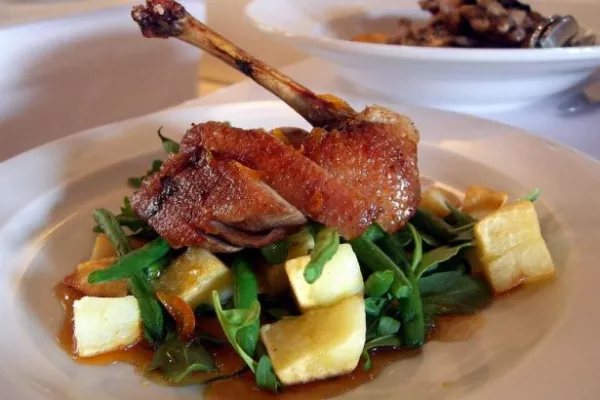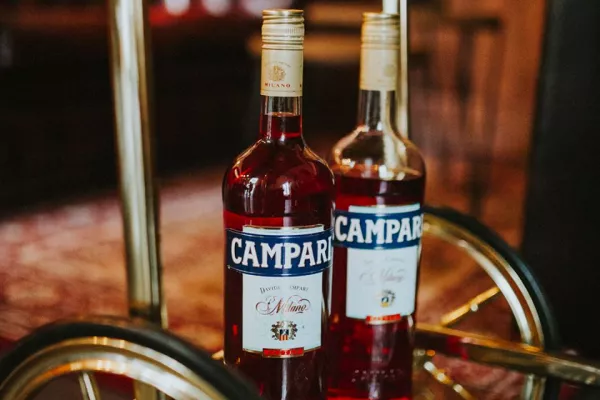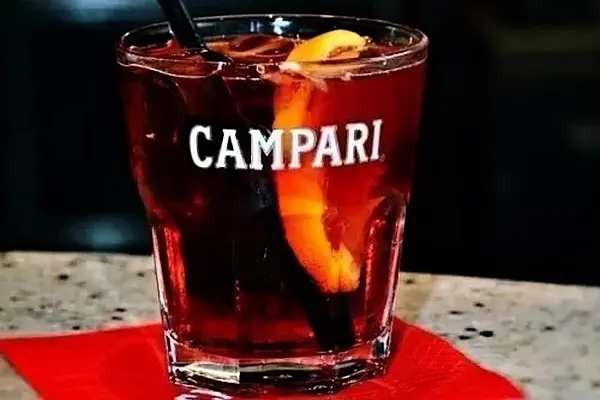Make way for ducklings.
New York has seen nothing in recent memory that compares to buzz for the Peking duck that will be the specialty at DaDong, set to open on 11 December. The three-story, 450-seat behemoth at Three Bryant Park will be the first US outpost for the Michelin-starred chain that has 14 locations around China (10 in Beijing, four in Shanghai, plus one coming to Chengdu). DaDong New York booked 2,500 reservations inside two hours when the restaurant opened for bookings on Oct. 11. The place is fully reserved until February, though the restaurant has room for daily walk-ins.
First off: What’s so great about this bird? Peking duck is a dish that originated in Beijing and is said to date back more than 700 years, to the Yuan Dynasty. By the mid 1500s, the first roast duck restaurant had opened in Beijing. DaDong’s version of the dish—a combination of lacquered skin and succulent meat, usually wrapped in a pancake with scallions and hoisin sauce—is magnificently crispy but meatier than much of the competition.
One reason it stands out is the way it’s cooked. Chef/owner Dong Zhenxiang uses customized Justa ovens whose design is top-secret; they have indentations on the walls that bring the oven temperature up to 600°F. The kitchen has a line of five such ovens, which can cook up to a dozen birds each; the ducks hang from a circular contraption on the top and rotate as they roast, so the fat drips. A battery of eight chefs sees to duck preparation: Two oversee the poultry cooking in the ovens, and six slicers present duck to guests and then carve it table-side: The neck meat is said to be the most tender.
At the table, various options are offered for eating the duck, which costs $98 complete and $58 for a half, cut four ways. Traditional-style comes with pancake, hoisin, and three to four pieces of duck meat (and skin), as well as watermelon radishes, cucumber, and scallion slices. There’s also a sesame-puff bun, a flaky pastry shell that’s meant to be stuffed with the duck meat, a pungent garlic paste, and vegetable garnishes. A further option is to dip the duck in a bowl of sugar and eat it plain. Finally, there’s the Kaluga caviar accompaniment, which costs an additional $42 and is meant to be spooned between the skin and the meat.
Where It Comes FromChef Zhenxiang sources the duck from Indiana-based Maple Leaf Farms Inc. The chef worked for two years to procure enough ducks for the deluge that the New York opening requires. DaDong ordered 960 ducks, enough to fill two walk-in coolers.
To accompany the food, beverage director Michael Scaffidi has assembled a wine list of more than 300 bottles. He’s drawing inspiration from the 12-year cycle of the Chinese zodiac system. “The year 2018 is the year of the dog; we’ll be featuring wines from 2006 and corresponding vintages,” said Scaffidi. There will be specialty mixed drinks, too. “It’s the sign of amazing people like Prince, Madonna, Michael Jackson; we’ll have some fun with that with the cocktail program.” He highlights Champagne and white Burgundy on the list—noting that both are duck-friendly—with a few by-the-glass selections, including Krug ($48). A handful of Chinese wines will be on offer, including cabernet sauvignons from the LVMH-owned Ao Yun Cabernet Sauvignon (for about $777) and Shanghai Moser ($59).
More than 100 bottles will be priced at less than $60. “We’re not here just to sell baller wines,” he says. He’s also planning to serve Frozé from a machine at the terrace on the second floor, where he might also experiment with such drinks as a frozen Ferrari (a mix of Fernet and Campari).
Sprawling in SizeAlthough the 17,500-square-foot, 450-seat space is huge for New York—by comparison, the massive Tao Downtown has just 300 seats—it’s tiny by DaDong’s standards. Their Chinese counterparts have up to 700 seats. Size was Zhenxiang’s biggest challenge when he began scouting New York locations in 2015. He decided he could make the biggest splash in a space near Times Square that had the size to accommodate a vast number of guests (there are 182 seats on the main floor, along with 160 on the outdoor terrace and more than 100 upstairs, where the chef will offer tasting menus with sliding walls for private dining). Zhenxiang liked the array of people that visit the area and appreciated that the Bank of China’s new headquarters is nearby, at 7 Bryant Park, and the Bank of America Tower is across the street.
The noise at DaDong is all about the duck, yet 79 other items list on the hardcover menu, which is decorated with big color pictures and resembles a children’s book. (As with the dining space, the menus in China are notably bigger, offering about 240 items; many dishes that didn’t make it to the U.S. were deemed not especially appealing to American palates, such as stir-fried Chinese lasagna with powdered crab roe and crab fat and sweet and sour jellyfish with aged vinegar.) Chef Andy Xu, a veteran of such esteemed New York kitchens as Cru, oversees the non-duck dishes. Xu predicts that the steamed Alaskan king crab (market price) will be the next bestseller, followed by Kung Pao chicken or shrimp. Yes, there’s Kung Pao shrimp on the menu. Word is, it’s really good.
News by Bloomberg - edited by Hospitality Ireland









